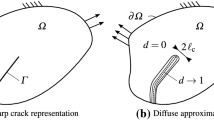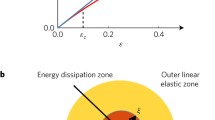Abstract
Using an energy formulation including the work of viscous dissipation, fracture initiation and growth in linearly viscoelastic materials has been investigated. Assuming the viscoelastic character of the criterion is the same for all geometries as for the spherical cavity studied, the appropriate extension of the Griffith initiation criterion is believed established. Inasmuch as the threshold is time dependent, illustrative results are presented for four typical loading inputs, namely constant stress (strain), and constant stress rate (strain rate). If inertia effects are neglected, the formulation also permits a direct calculation of flaw size with time.
Résumé
L’initiation et la croissance de la rupture dans les matériaux viscoélastiques a été analysée en utilisant une formulation de l’énergie englobant le travail de dissipation visqueuse. En admettant que le caractère viscoélastique du critère est le même pour toutes les géométriés que pour la cavité sphérique étudiée, l’extension appropriée du critère d’initiation de Griffith est supposée établie. Pour autant que le seuil dépende du temps, des résultats sont présentés à titre d’exemple, pour quatre applications de charge typiques à savoir déformation (contrainte) constante, et vitesse de déformation (contrainte) constante. Si on néglige les effets d’inertie, la formulation permet aussi un calcul direct des dimensions des fissures dans le temps.
Zusammenfassung
Bruchauslösung und Bruchausbreitung in linear viskoelastischen Materialien wurden untersucht, wobei eine energetische Formulierung, welche die Arbeit der viskösen Dissipation berücksichtigt, verwendet wurde. Unter der Annahme, dass der viskoelastische Charakter des Kriteriums für alle geometrischen Formen der gleiche ist wie für den untersuchten Kugelhohlraum, wird die entsprechende Erweiterung des Griffith’schen Auslösungskriteriums als gegeben erachtet. In bezug auf die Zeitabhängigkeit dessen Grenzwertes werden anschauliche Resultate für vier typische Belastungen gezeigt, und zwar für konstante Kraft (Beanspruchung) und konstante Kraft- (Beanspruchungs-) Geschwindigkeit. Unter Vernachlässigung der Träg-licitseinflüsse erlaubt die Formulierung auch eine direkte Berechnung der Rissgrösse mit der Zeit.
Similar content being viewed by others
References
A.A. Griffith, The Theory of Rupture, Proceedings of the First International Congress of Applied Mechanics, Delft, 1924, pp.55–63.
E. Orowan, Fundamentals of Brittle Behavior in Metals, Fatigue and Fracture of Metals, Murray, W.M., editor, John Wiley and Sons, 1952, pp.139–167.
G.R. Irwin, Fracture Dynamics, Fracturing of Metals, American Society for Metals, Cleveland, 1948, pp.147–166.
R.S. Rivlin and A.G. Thomas. Rupture of Rubber. Part I. Characteristic Energy for Tearing, Journal of Polymer Science, Vol.10, No.3, 1953, p.291.
M.L. Williams. The Fracture of Viscoelastic Material, Fracture of Solids, Interscience Publishers, New York, 1963, pp. 157–188.
M.L. Williams, R.F. Landel and J.D. Ferry. The Temperature Dependence of Relaxation Mechanisms in Amorphous Polymers and Other Glass-forming Liquids, Journal of the American Chemical Society, Vol.77 1955, pp.3701–3707.
E. Orowan, Energy Criteria of Fracture, Welding Research Supplement, The Welding Journal, Vol.34, No.3, 1955, p.157.
I. S. Sokolnikoff, Mathematical Theory of Elasticity, McGraw-Hill Book Company, Inc., New York, 1956.
R.A. Schapery and M.L. Williams. On the Acceleration of Cracks in Viscoelastic Media, GALCIT SM 62-39, California Institute of Technology, Pasadena, California, September 1962.
W.G. Knauss. Energy Considerations Relating to Viscoelastic Materials, GALCIT SM 64-11, California Institute of Technology, Pasadena, California, April 1964.
E. Betz, Mechanical Property of Solithane 113, GALCIT SM 65-12, California In-stitute of Technology, Pasadena, California, July 1965.
T.L. Smith, Ultimate Tensile Properties of Elastomers. I. Characterization by a Time and Temperature Independent Failure Envelope, Journal of Polymer Science, Part A, Vol.1, 1963, pp.3597–3615.
I.N. Sneddon, The Distribution of Stress in the Neighbourhood of a Crack in an Elastic Solid, Proceedings of the Royal Society (London), Series A, Vol.187, October 1946, pp.229–260.
H.W. Greensmith. Rupture of Rubber, Part VII. Effect of Rate of Extension in Tensile, Journal of Polymer Science, Vol.3, No.8, 1960, pp.175–182.
A.G. Thomas, Rupture of Rubber, Part II. The Strain Concentration at an Incision, Journal of Polymer Science, Vol.18, 1955, p.177.
M.L. Williams and R.A. Schapery. Spherical Flaw Instability in Hydrostatic Tension, International Journal of Fracture Mechanics, Vol.1, No.1, March 1965, pp. 64–72.
M.L. Williams, The Structural Analysis of Viscoelastic Materials, AIAA Journal, Vol.2, No.5, May 1965, pp.405–411.
G.H. Lindsey. Unpublished results, California Institute of Technology, Pasadena, California.
T.L. Smith. Nonlinear Viscoelastic Response of Amorphous Elastomers to Constant Strain Rates, Transactions of Society of Rheology, Vol.6, 1962, pp.61–80.
E. Guth, P.E. Wack, and R.L. Anthony. Significance of the Equation of State for Rubber, Journal of Applied Physics, Vol.17, 1946, p.347.
M.L. Williams and R.A. Schapery. Studies of Viscoelastic Media, ARL 62-366, Aerospace Research Laboratories, Office of Aerospace Research, United States Air Force, Wright-Patterson Air Force Base, Ohio, June 1962 (AD 278 809).
W.G. Knauss, A Cross-Linked Polymer Standard Report on Polymer Selection, MATSCIT PS 65-3, Keck Laboratory of Engineering Materials, California Institute of Technology, Pasadena, California, April 1965.
H.W. Greensmith and A.G. Thomas, Rupture of Rubber. Part III. Determining of Tear Properties, Journal of Polymer Science, Vol.18, 1955, pp. 189–200.
G.H. Lindsey, Ph.D.Dissertation, Aeronautics Department, California Institute of Technology, Pasadena, California, 1966.
Author information
Authors and Affiliations
Rights and permissions
About this article
Cite this article
Williams, M.L. Initiation and Growth of Viscoelastic Fracture. Int J Fract 1, 292–310 (1965). https://doi.org/10.1007/BF03545561
Received:
Published:
Issue Date:
DOI: https://doi.org/10.1007/BF03545561




